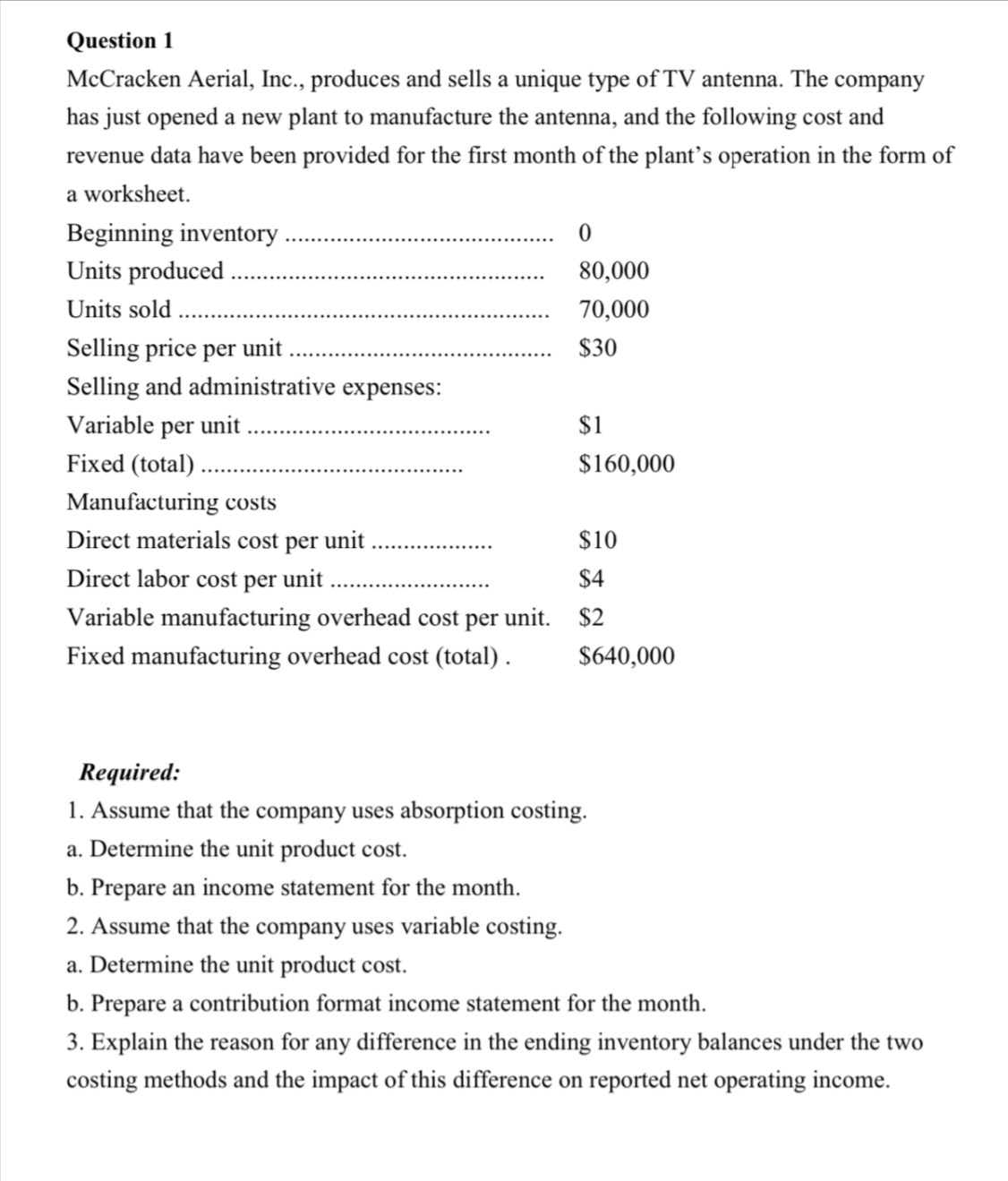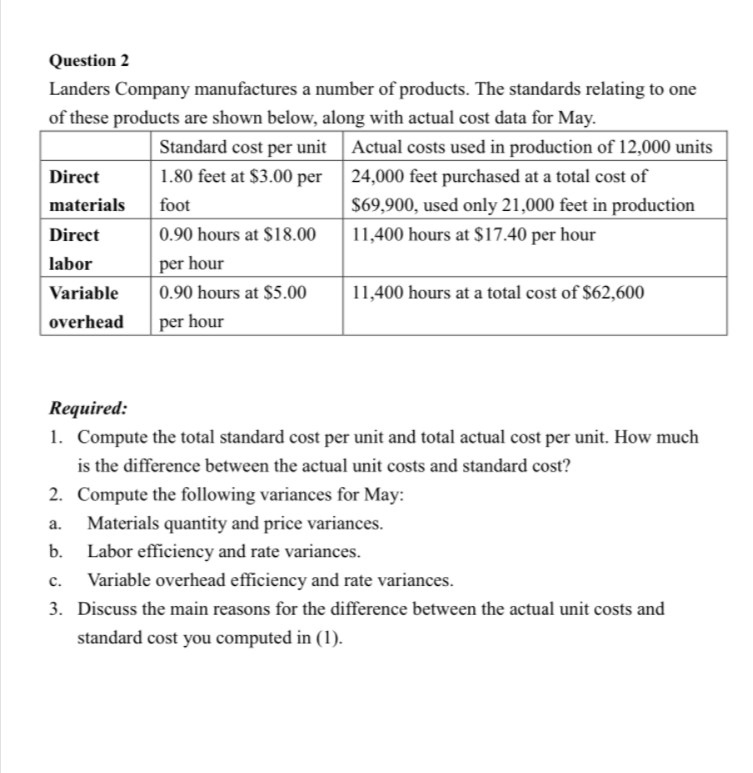Question 1 McCracken Aerial, Inc., produces and sells a unique type of TV antenna. The company has just opened a new plant to manufacture the antenna, and the following cost and revenue data have been provided for the first month of the plant’s operation in the form of a worksheet. Beginning inventory Units produced Units sold . 80,000 70,000 Selling price per unit $30 Selling and administrative expenses: Variable per unit $1 Fixed (total) .. $160,000 Manufacturing costs Direct materials cost per unit $10 Direct labor cost per unit $4 Variable manufacturing overhead cost per unit. $2 Fixed manufacturing overhead cost (total) . $640,000 Required: 1. Assume that the company uses absorption costing. a. Determine the unit product cost. b. Prepare an income statement for the month. 2. Assume that the company uses variable costing. a. Determine the unit product cost. b. Prepare a contribution format income statement for the month. 3. Explain the reason for any difference in the ending inventory balances under the two costing methods and the impact of this difference on reported net operating income. Question 2 Landers Company manufactures a number of products. The standards relating to one of these products are shown below, along with actual cost data for May. Standard cost per unit Actual costs used in production of 12,000 units 1.80 feet at $3.00 per 24,000 feet purchased at a total cost of $69,900, used only 21,000 feet in production Direct materials foot Direct 0.90 hours at $18.00 11,400 hours at $17.40 per hour labor per hour Variable 0.90 hours at $5.00 11,400 hours at a total cost of $62,600 overhead per hour Required: 1. Compute the total standard cost per unit and total actual cost per unit. How much is the difference between the actual unit costs and standard cost? 2. Compute the following variances for May: a. Materials quantity and price variances. b. Labor efficiency and rate variances. с. Variable overhead efficiency and rate variances. 3. Discuss the main reasons for the difference between the actual unit costs and standard cost you computed in (1).
Question 1 McCracken Aerial, Inc., produces and sells a unique type of TV antenna. The company has just opened a new plant to manufacture the antenna, and the following cost and revenue data have been provided for the first month of the plant’s operation in the form of a worksheet. Beginning inventory Units produced Units sold . 80,000 70,000 Selling price per unit $30 Selling and administrative expenses: Variable per unit $1 Fixed (total) .. $160,000 Manufacturing costs Direct materials cost per unit $10 Direct labor cost per unit $4 Variable manufacturing overhead cost per unit. $2 Fixed manufacturing overhead cost (total) . $640,000 Required: 1. Assume that the company uses absorption costing. a. Determine the unit product cost. b. Prepare an income statement for the month. 2. Assume that the company uses variable costing. a. Determine the unit product cost. b. Prepare a contribution format income statement for the month. 3. Explain the reason for any difference in the ending inventory balances under the two costing methods and the impact of this difference on reported net operating income. Question 2 Landers Company manufactures a number of products. The standards relating to one of these products are shown below, along with actual cost data for May. Standard cost per unit Actual costs used in production of 12,000 units 1.80 feet at $3.00 per 24,000 feet purchased at a total cost of $69,900, used only 21,000 feet in production Direct materials foot Direct 0.90 hours at $18.00 11,400 hours at $17.40 per hour labor per hour Variable 0.90 hours at $5.00 11,400 hours at a total cost of $62,600 overhead per hour Required: 1. Compute the total standard cost per unit and total actual cost per unit. How much is the difference between the actual unit costs and standard cost? 2. Compute the following variances for May: a. Materials quantity and price variances. b. Labor efficiency and rate variances. с. Variable overhead efficiency and rate variances. 3. Discuss the main reasons for the difference between the actual unit costs and standard cost you computed in (1).
Managerial Accounting: The Cornerstone of Business Decision-Making
7th Edition
ISBN:9781337115773
Author:Maryanne M. Mowen, Don R. Hansen, Dan L. Heitger
Publisher:Maryanne M. Mowen, Don R. Hansen, Dan L. Heitger
Chapter2: Basic Managerial Accounting Concepts
Section: Chapter Questions
Problem 26BEA
Related questions
Question

Transcribed Image Text:Question 1
McCracken Aerial, Inc., produces and sells a unique type of TV antenna. The company
has just opened a new plant to manufacture the antenna, and the following cost and
revenue data have been provided for the first month of the plant’s operation in the form of
a worksheet.
Beginning inventory
Units produced
Units sold .
80,000
70,000
Selling price per unit
$30
Selling and administrative expenses:
Variable per
unit
$1
Fixed (total) ..
$160,000
Manufacturing costs
Direct materials cost per unit
$10
Direct labor cost per unit
$4
Variable manufacturing overhead cost per unit. $2
Fixed manufacturing overhead cost (total) .
$640,000
Required:
1. Assume that the company uses absorption costing.
a. Determine the unit product cost.
b. Prepare an income statement for the month.
2. Assume that the company uses variable costing.
a. Determine the unit product cost.
b. Prepare a contribution format income statement for the month.
3. Explain the reason for any difference in the ending inventory balances under the two
costing methods and the impact of this difference on reported net operating income.

Transcribed Image Text:Question 2
Landers Company manufactures a number of products. The standards relating to one
of these products are shown below, along with actual cost data for May.
Standard cost per unit Actual costs used in production of 12,000 units
1.80 feet at $3.00 per 24,000 feet purchased at a total cost of
$69,900, used only 21,000 feet in production
Direct
materials
foot
Direct
0.90 hours at $18.00
11,400 hours at $17.40 per hour
labor
per hour
Variable
0.90 hours at $5.00
11,400 hours at a total cost of $62,600
overhead
per hour
Required:
1. Compute the total standard cost per unit and total actual cost per unit. How much
is the difference between the actual unit costs and standard cost?
2. Compute the following variances for May:
a.
Materials quantity and price variances.
b.
Labor efficiency and rate variances.
с.
Variable overhead efficiency and rate variances.
3. Discuss the main reasons for the difference between the actual unit costs and
standard cost you computed in (1).
Expert Solution
This question has been solved!
Explore an expertly crafted, step-by-step solution for a thorough understanding of key concepts.
This is a popular solution!
Trending now
This is a popular solution!
Step by step
Solved in 2 steps

Recommended textbooks for you

Managerial Accounting: The Cornerstone of Busines…
Accounting
ISBN:
9781337115773
Author:
Maryanne M. Mowen, Don R. Hansen, Dan L. Heitger
Publisher:
Cengage Learning

Cornerstones of Cost Management (Cornerstones Ser…
Accounting
ISBN:
9781305970663
Author:
Don R. Hansen, Maryanne M. Mowen
Publisher:
Cengage Learning

Principles of Accounting Volume 2
Accounting
ISBN:
9781947172609
Author:
OpenStax
Publisher:
OpenStax College

Managerial Accounting: The Cornerstone of Busines…
Accounting
ISBN:
9781337115773
Author:
Maryanne M. Mowen, Don R. Hansen, Dan L. Heitger
Publisher:
Cengage Learning

Cornerstones of Cost Management (Cornerstones Ser…
Accounting
ISBN:
9781305970663
Author:
Don R. Hansen, Maryanne M. Mowen
Publisher:
Cengage Learning

Principles of Accounting Volume 2
Accounting
ISBN:
9781947172609
Author:
OpenStax
Publisher:
OpenStax College

Managerial Accounting
Accounting
ISBN:
9781337912020
Author:
Carl Warren, Ph.d. Cma William B. Tayler
Publisher:
South-Western College Pub
